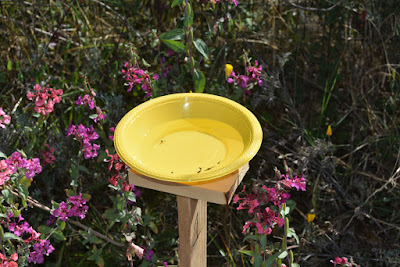 |
| Mother Nature's Backyard provides pollinator and bird habitat. |
Summer is our peak insect season in
Southern California. And 2017 is a
fantastic year for garden insects! The
winter rains have helped a number of species – from butterflies to tiny flower
flies – bounce back. We hope you’re
taking the time to enjoy them.
Habitat gardening is gaining
popularity throughout the world. As
green space disappears, more gardeners are choosing plants for their habitat
value. In doing so, we take it on faith that if we plant the right plants, the insects and other creatures will come.
But how much difference can one small
garden really make?
That’s just the kind of question that
biologists like to ask – and try to answer.
To that end, the UC Berkeley Bee Lab (http://www.helpabee.org/)
is monitoring bees in gardens throughout the state. In S. California, they currently have sites
in Camarillo, La Canada/Flintridge, Palm Springs and Riverside. We look forward
to seeing the results of their monitoring efforts in these gardens.
 |
| Several species of native Buckwheats attract summer insects. |
Unfortunately, the Berkeley Bee Lab has no sites yet in
western Los Angeles County. That’s a
shame – there are many interesting pollinators in our local gardens. Are the insects different from those of other
areas? Are there (as yet) undiscovered
pollinator species in western L.A. County?
What locally native plants are important for the specialist
pollinators? What pollinator species can
a small, typical suburban garden support? All of these are questions begging for
answers.
 |
| Jesus Cepeda, Cal Poly Pomona, examines trap. |
And that’s why Mother Nature’s Backyard is currently participating in a study designed to answer some of those questions – at least for the bees. Jesus Cepeda, a Master’s Degree Candidate at Cal Poly Pomona, is conducting a study of bee pollinators in six native plant gardens in Los Angeles County. Most are home gardens; but one is Mother Nature’s Backyard.
Cepeda is a bee biologist. He wants to know whether native plant gardens
attract the same types of native bees as are found in natural areas. He’s also interested
in questions of seasonality, floral density and floral species relationships. And so, about every six weeks, he visits each
garden to see what’s flying.
 |
| Collection in Mother Nature's Backyard |
Cepeda uses several collection
methods. He utilizes pan traps (small
plastic bowls filled with soapy water) to collect the smaller species. These are yellow, blue,
white and red; he leaves them in place for 24 to 48 hours. He also uses a net to capture some of the
larger species. He takes them back to
the lab, preserves them and determines what species they are. His results will ultimately be analyzed and
published.
 |
| Cepeda surveys a sunny, July garden |
So, does one small garden
matter? The jury is still out, but the
hints are promising. Bigger is better, certainly,
but even small gardens are likely to provide important habitat. We suspect that
interesting answers – specific to our area - will emerge in the next few years.
The data will help us spread the news
about the importance of habitat gardening.
Someday, entire local neighborhoods may provide crucial pollinator
habitat. That’s an exciting thought!
In the meantime, you can help the
effort by photographing your garden insects and uploading them to iNaturalist (https://www.inaturalist.org/home). It’s fun and easy – you may even learn the
names of the insects. And you’ll be
doing something no one else can: documenting the insects in your garden for science and for posterity.
Want
to learn more about habitat gardening? See:
We encourage your comments below.
If you have questions about Duskywing butterflies or other gardening
topics you can e-mail us at : mothernaturesbackyard10@gmail.com



I feel in my bones that even small gardens matter. Looking forward to seeing the results.
ReplyDelete